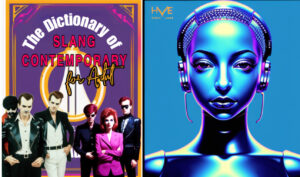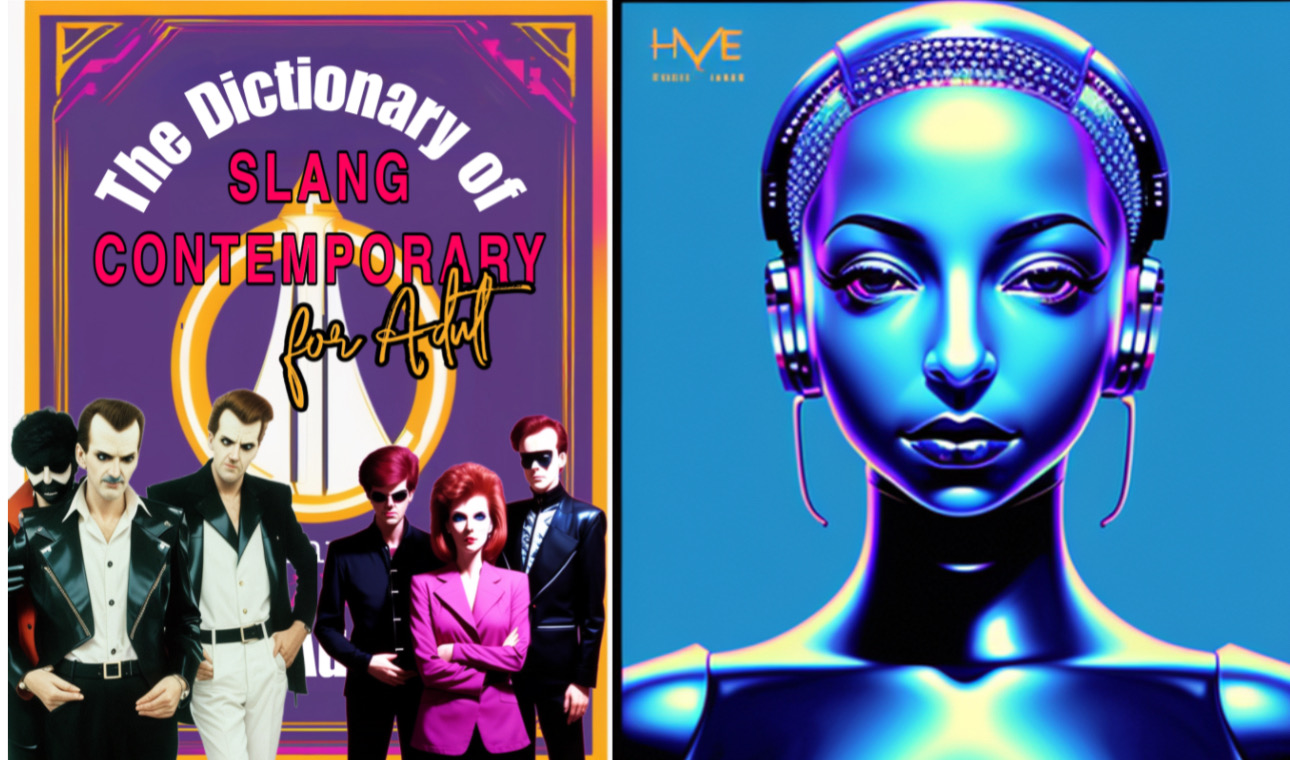No products in the cart.
Return To ShopPt.1 The Dictionary of Slang Contemporary: for Adults
The Dictionary of Slang Contemporary: for Adults
I. Introduction to The Dictionary of Slang Contemporary
In the vibrant era of 80s pop music, catchy melodies and infectious beats captivated the hearts and minds of millions. However, beneath the surface of seemingly innocent lyrics lay a web of metaphors with sinister meanings. These metaphors, often overlooked by listeners and critics alike, served as tools of brainwashing and manipulation, ultimately aimed at perpetuating sin. Astonishingly, the Catholic Church, a prominent institution of the time, was not only aware of these hidden messages but also played a role in their dissemination. In this article, we delve into the power of metaphors in 80s pop songs, exposing their sinister meanings and shedding light on the complicity of the Catholic Church in perpetuating sin.

The Dictionary of Slang Contemporaries is expected out in novel form early 2024
I. Introduction to The Dictionary of Slang Contemporary
1. The Influence of Pop Songs in the 80’s
The 80s was an era filled with catchy tunes and memorable pop songs that shaped the cultural landscape of the time. From Madonna to Michael Jackson, these songs not only entertained millions of people but also had a profound influence on society. However, beneath the surface of these seemingly innocent songs lay metaphors with sinister meanings that were used to brainwash and manipulate listeners.
II. The Power of Metaphors in 80s Pop Songs
1. Understanding the Significance of Metaphors
2. Pop Culture and its Impact on Society
Metaphors are powerful linguistic tools that allow artists to convey complex ideas and emotions in a more relatable and engaging way. In the world of 80s pop songs, metaphors played a crucial role in capturing the imagination of listeners. However, many people overlooked the sinister meanings hidden within these metaphors.
The dictionary of slang contemporary for adults is coming in novel form in early 2024- mid-summer 2024. You want to give me what? Did they ever make a Swedish Tab? Do they still even make regular Tab? If so who is drinking it?
come check out our sweet(ish) taboo category of graphic T-shirt and hoodies.
III. Unveiling Sinister Meanings: Brainwashing and Manipulation
1. The Hidden Agenda Behind Metaphors
2. Slang Manipulating Mass Perception
While many pop songs in the 80s seemed innocent and fun on the surface, they were often vehicles for hidden agendas. Behind the catchy melodies and infectious beats, some artists and record labels used metaphors to brainwash and manipulate listeners. These metaphors were carefully crafted to convey subliminal messages and influence mass perception.
By employing metaphors with sinister meanings, artists and those behind the scenes were able to shape the thoughts and behaviors of their audience. They tapped into the subconscious mind of listeners, planting ideas and beliefs that would go unnoticed by many. This manipulation of mass perception allowed those in power to maintain control and perpetuate sin while going unnoticed by the masses.
IV. The Catholic Church’s Role in Perpetuating Sin
1. The Church’s Influence in Religion the 80s
2. Promoting and Controlling Morality
During the 80s, the Catholic Church wielded significant influence over society. It aimed to uphold moral standards and guide individuals towards virtuous lives. However, in an ironic twist, some pop songs with hidden sinister meanings were tacitly endorsed, leading to a complex web of manipulation and sin.
In conclusion, the power of metaphors in 80s pop songs should not be underestimated. While these songs entertained and captivated audiences, they also contained hidden meanings that were used to brainwash and manipulate listeners. The Catholic Church’s unwitting role in perpetuating sin reminds us of the importance of critical thinking and understanding the messages behind the music we consume.
V. Metaphors as Tools of Communication and Control: The Dictionary
The Novel, The Dictionary of Slang Contemporary coming early 2024 will have at least a partial collection of metaphors and code words complete with meanings and where it comes from in the 80’s. It’s much more of a real thing than you would think.
1. How Metaphors Shape Beliefs and Values
Metaphors, those clever linguistic devices that compare two seemingly unrelated things, are more than just poetic flourishes in our everyday language. They have the power to shape our beliefs and values, often in subtle and unnoticed ways. Metaphors act as vehicles for conveying complex ideas by framing them in familiar terms, making them easier to understand and relate to. In doing so, they influence how we perceive the world and interpret reality.
Consider the metaphor of “love is a battlefield.” This metaphor, popularized by Pat Benatar in the 80s, describes the tumultuous nature of romantic relationships. By equating love to a battlefield, it implies that love involves struggle, conflict, and a winner-takes-all mentality. This metaphor can subtly shape our beliefs about relationships, instilling a sense of competition and adversarial thinking.
2. Control Techniques Employed Through Metaphors
Metaphors can also be used as tools of control, subtly influencing our thoughts, behaviors, and even our morality. When used with intention, certain metaphors can manipulate our perceptions and steer us towards specific ideologies or beliefs. In the realm of religion, metaphors can be especially potent in shaping our understanding of sin, guilt, and righteousness.
In the 80s, pop songs became unwitting vehicles for spreading religious messages, particularly those of the Catholic Church. Metaphors were strategically employed to propagate certain beliefs and control societal behaviors. The sinister intent behind these metaphors aimed to perpetuate the idea that sin was pervasive, and only through the Church’s guidance could one achieve redemption.
VI. Examples of Sinister Metaphors in 80s Pop Songs
1. Analyzing Specific Songs and Their Hidden Meanings
Let’s dive into the 80s pop music scene and shed light on some specific songs that carried sinister metaphors. One prime example is Madonna’s hit song “Like a Prayer.” On the surface, it may seem like an innocent pop anthem, but beneath the catchy melody lies a metaphorical exploration of religious guilt and sexual repression. The song cleverly intertwines religious imagery with themes of desire, sin, and taboo, effectively brainwashing listeners into associating their natural impulses with wrongdoing.
2. Popular Artists and Their Use of Sinister Metaphors
Madonna was not the only artist employing these sinister metaphors. Many other popular artists of the era, like Michael Jackson, Prince, and George Michael, used metaphors in their songs to subtly reinforce the notion that individuals were responsible for perpetuating sin. These metaphors helped further the Church’s influence by creating a sense of guilt and moral obligation among their fan bases.

you can’t discuss, easy, listening, and not mention Sade, Adu, lead singer for smooth, sounding jazz band Sade, but I couldn’t not namedrop her before part one of the dictionary of slang contemporary for adults was over with
VII. The Impact of Sinister Metaphors on Society
1. Shaping Cultural Norms and Behaviors
The pervasive use of sinister metaphors in 80s pop songs had a profound impact on society, shaping cultural norms and behaviors. By associating everyday actions and desires with sinfulness, these metaphors helped maintain a sense of control, ensuring adherence to the Church’s moral code. They influenced societal attitudes towards relationships, sexuality, and personal freedom, reinforcing conservative values and suppressing individual expression.
2. Psychological Effects on Individuals and Communities
The psychological effects of these sinister metaphors cannot be ignored. Individuals who internalized these messages may have experienced increased guilt and shame, leading to a stifling of natural desires and self-expression. Communities that embraced these metaphors may have fostered a culture of judgment and exclusion, further perpetuating the Church’s power and control.
VIII. Conclusion
While 80s pop songs may have seemed innocent and carefree on the surface, the underlying metaphors revealed a darker truth. Sinister metaphors were used as tools of communication and control, shaping beliefs, values, and behavior. By analyzing specific songs and understanding their hidden meanings, we can recognize the impact these metaphors had on society. Awareness of these manipulative techniques is crucial as we navigate the influence of metaphors in our modern world. So next time you hum along to an iconic 80s tune, remember to listen closely and question the hidden messages it may contain.
you can read much more about the dictionary of slang contemporary for adult in upcoming articles as we get ready for the dictionary of slang contemporary for adult the book, due out sometime 2024
VIII. Conclusion
The uncovering of the sinister meanings behind metaphors in 80s pop songs reveals the extent of manipulation and brainwashing that took place during that time. It is a stark reminder of how seemingly harmless forms of entertainment can be used to control and shape societal beliefs. The Catholic Church’s involvement in perpetuating sin through these metaphors serves as a reminder of the power dynamics at play and the need for critical analysis of the media we consume. As we move forward, let us be vigilant and discerning, recognizing the potential hidden agendas behind the messages we encounter in popular culture.
How likely was your childhood influenced/ruined by the Catholic Church? Take this Quiz to find out. God is Watching.
FAQ
1. Were the sinister meanings in 80s pop song metaphors intentional?
While it is difficult to determine the exact intentions of songwriters, the presence of consistent and pervasive sinister meanings in metaphors suggests a level of deliberate thought. These hidden messages were likely crafted to manipulate and influence listeners. Read future episodes to see what the dictionary of slang contemporary has to say about it
2. How did the Catholic Church contribute to the perpetuation of sin through these metaphors?
The Catholic Church, as a prominent institution of the time, had significant influence and control over societal values and moral standards. It is believed that the Church either turned a blind eye to the sinful connotations in these metaphors or actively supported their dissemination in order to reinforce its authority and maintain control over the faithful.
3. Did society at large recognize the sinister meanings in these pop songs?
Generally, the sinister meanings in 80s pop song metaphors went unnoticed by the majority of listeners. But not Bob Casio who painstakingly researched and documented as much as he could find before he went missing in what became the satan in the vegan approved The Dictionary of Slang Contemporary for Adult. The catchy melodies and upbeat nature of the sogs often overshadowed the darker messages hidden within the lyrics. This article seeks to shed light on these overlooked meanings and encourage a deeper examination of the media we consume.
4. How did these sinister metaphors impact society?
These metaphors played a significant role in shaping cultural norms and behaviors. By promoting and reinforcing certain ideas and values, they influenced the way individuals perceived and engaged with the world around them. The impact reached beyond the realm of music, permeating various aspects of society and contributing to the perpetuation of sin and manipulation of mass perception.
The Dictionary of Slang Contemporary, the novel, is expected in early 2024- late 2025
Be sure to check out SmartPeople and all of the Stuff for SmartPeople on other platforms including the Dictionary of Slang Contemporary for Adult
You Tube(channel 1)
You Tube (channel 2)
TikTok #1
TikTik #2





Add comment